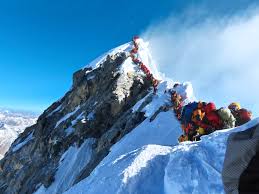
Mount Everest Body
Mount Everest, standing at a formidable 8,848 meters (29,029 feet) above sea level, is the highest peak on Earth. It attracts climbers from all corners of the globe, from highly experienced mountaineers to amateur adventurers seeking to conquer its summit. However, beneath the allure of Everest’s majestic heights lies a stark, often overlooked reality: the mountain is also home to the bodies of those who perished in their quest to reach its summit. These bodies, now frozen and preserved by the mountain’s harsh conditions, tell stories of ambition, bravery, and the perilous nature of high-altitude climbing.
The Harsh Environment of Everest
Everest’s extreme environment is both a draw and a danger. The atmospheric pressure at the summit is only about one-third of what it is at sea level, leading to significantly reduced oxygen levels. This results in what climbers call the “death zone” — altitudes above 8,000 meters (26,247 feet) where the human body can no longer acclimatize and slowly begins to deteriorate. Here, even simple tasks become monumental, and the risks of frostbite, hypothermia, and acute mountain sickness increase exponentially.
The treacherous conditions mean that when climbers die on Everest, their bodies often remain where they fell. The combination of thin air, low temperatures, and difficult terrain makes recovery efforts nearly impossible and, in many cases, too dangerous to attempt.
Notable Cases
Over the decades, many climbers have lost their lives on Everest. Some of the most notable cases have become almost legendary among the climbing community.
George Mallory and Andrew Irvine: One of the earliest and most famous cases is that of British climbers George Mallory and Andrew Irvine, who disappeared near the summit in 1924. Mallory’s body was discovered in 1999, remarkably well-preserved by the mountain’s cold, dry air. The discovery reignited the debate over whether Mallory and Irvine were the first to reach the summit, a mystery that remains unsolved due to the absence of Irvine’s body and the camera he was reportedly carrying.
Green Boots: Another well-known case is that of “Green Boots,” a moniker given to an unidentified climber whose body, wearing bright green boots, lies in a prominent position on the main Northeast Ridge route. For years, Green Boots served as a grim landmark for climbers on their way to the summit, a stark reminder of the mountain’s dangers.
Francys Arsentiev: In 1998, Francys Arsentiev, an American climber, became the first American woman to reach the summit without supplemental oxygen. However, she and her husband, Sergei Arsentiev, encountered severe difficulties during their descent. Francys eventually succumbed to exhaustion and exposure. Her body, which was located near the summit, became another poignant symbol of the perils faced by climbers on Everest.
The Ethics of Everest Climbing
The presence of bodies on Everest raises complex ethical questions. The decision to climb the mountain, knowing that many before have died, weighs heavily on climbers. Additionally, there is the question of whether to attempt rescues or recover bodies in such an inhospitable environment. Climbers must balance their own safety with the moral imperative to help others in distress.
In recent years, efforts have been made to recover some of the bodies, driven by both ethical considerations and the growing environmental impact of Everest expeditions. However, these efforts are fraught with challenges. High-altitude recoveries are perilous and require specialized teams who must navigate the same deadly conditions that claimed the climbers’ lives.
Environmental Impact
Beyond the human cost, the high number of expeditions to Everest has led to significant environmental degradation. The mountain is littered with the remnants of past climbs, including discarded equipment, oxygen bottles, and the bodies of climbers. These human and material remnants contribute to what has been called the “world’s highest garbage dump.”
Efforts to clean up Everest have been initiated by both governments and private organizations. Expeditions specifically aimed at removing trash and human remains have had some success, but the sheer volume of waste and the ongoing influx of climbers make it a daunting task.
The Future of Climbing on Everest
As more climbers flock to Everest each year, the risks and ethical dilemmas associated with the mountain continue to grow. The commercialization of Everest expeditions has made the summit more accessible to those with the financial means, but not necessarily the experience, to undertake such a perilous journey. This influx has led to overcrowding, which exacerbates the dangers and increases the likelihood of accidents and fatalities.
Future solutions may include stricter regulations on the number of climbers allowed each season, mandatory cleanup efforts for each expedition, and improved safety protocols. Additionally, advances in technology, such as more accurate weather forecasting and better communication equipment, could help mitigate some of the risks.
Personal Reflections
For many climbers, the decision to tackle Everest is deeply personal, driven by a combination of ambition, a love of adventure, and the allure of one of the world’s ultimate challenges. The stories of those who perished on the mountain serve as both a warning and an inspiration. They remind us of the mountain’s unforgiving nature and the thin line between success and tragedy.
Climbers often reflect on the legacy they want to leave behind. Some hope to reach the summit and return safely, while others are motivated by a desire to push the boundaries of human endurance. The presence of bodies on Everest serves as a stark reminder of the mountain’s dual nature: a place of incredible beauty and profound danger.
Conclusion
Mount Everest remains a symbol of human aspiration and the relentless pursuit of achievement. However, the bodies that lie frozen on its slopes are a somber testament to the mountain’s lethal risks. As climbers continue to be drawn to its heights, the stories of those who did not return underscore the need for respect, preparedness, and a sober understanding of the challenges that lie ahead. Everest will always be a place where dreams and tragedy intersect, a monument to the indomitable spirit of human exploration and the formidable power of nature.







